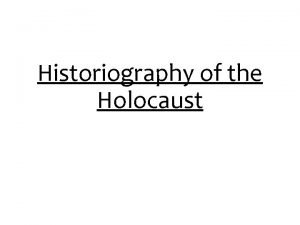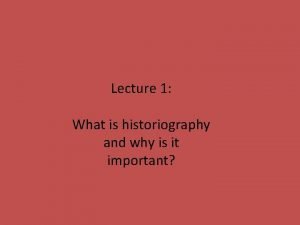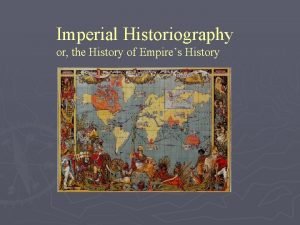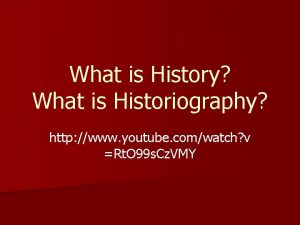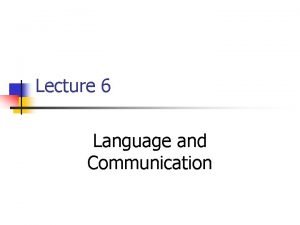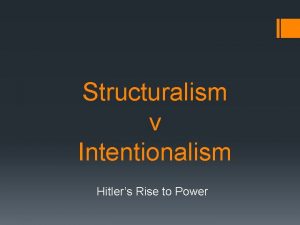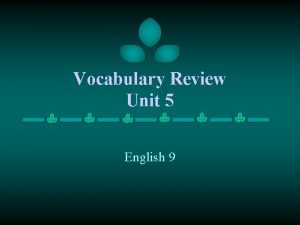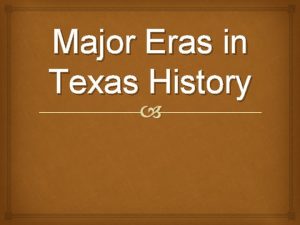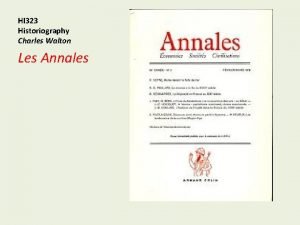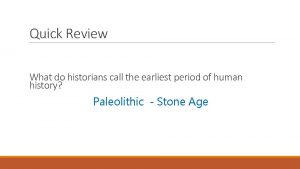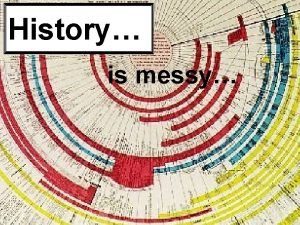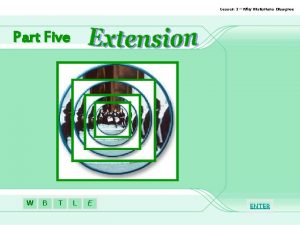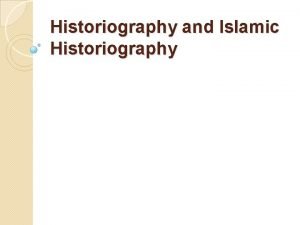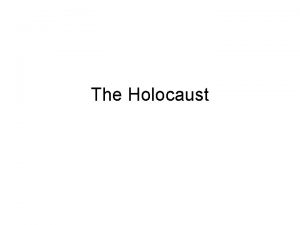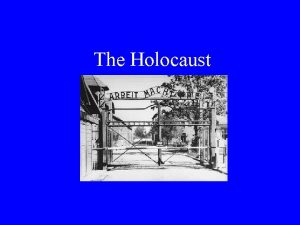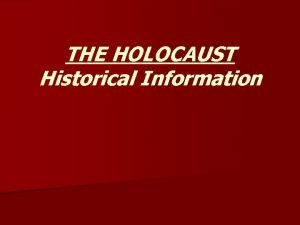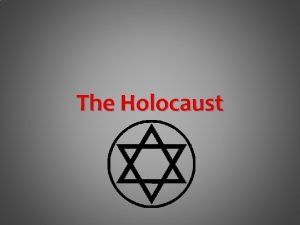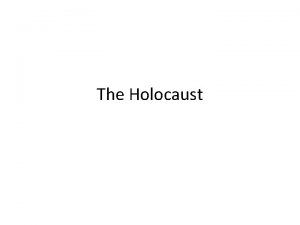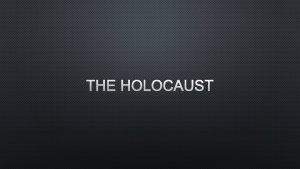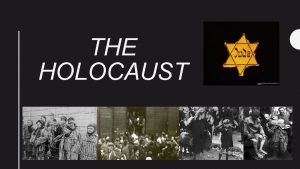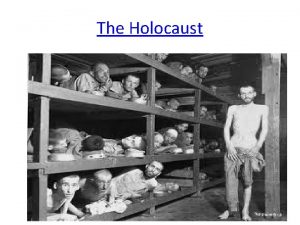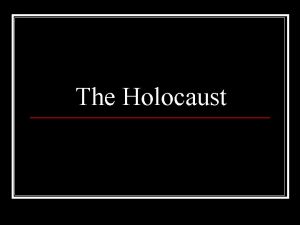Historiography of the Holocaust Intentionalist Most intentionalist historians














- Slides: 14

Historiography of the Holocaust

Intentionalist • Most intentionalist historians belong to a school of thought known as the Sonderweg (‘special path’). They argue that Germany’s fascination with authoritarianism, military conquest, racial purity and anti-Semitism pre-dated the Nazis by generations, back to mid-1800 s Prussia. These ideas and values not only survived, they shaped the newly unified Germany and contributed to the outbreak of World War I (1914), post-war radical nationalism and the rise of Nazism. According to Sonderweg historians, Nazism and the Holocaust were not significant deviations from the course of German history, they were its predictable end points.

Structuralists • Another group of historians, known as functionalists or structuralists, support the ‘weakfuhrer theory’. Hitler’s power over the Nazi Party, they argue, has been considerably overstated. They contend that Hitler made decisions spontaneously, haphazardly and unpredictably; he had few if any long term plans. Sometimes Hitler acted to maintain his position at the helm of the party, which was not as secure as is commonly believed. His introduction of the 1935 Nuremberg Laws, for example, was done to appease hardcore anti-Semites in the NSDAP. From this theory if follows that the Holocaust was the product of anti-Semitic forces in the Nazi movement, as much as it was a manifestation of Hitler’s personal will. Ian Kershaw, the leading functionalist historian of recent times, has also claimed the existence of a ‘Hitler myth’. Kershaw argues that the perception of Hitler as a dominant, all-powerful leader, ruling both party and state with an iron fist, was the product of Nazi propaganda rather than reality.

Key Nazis Name Joseph Goebbels (1897– 1945) Responsibility Minister of Propaganda, 1933– 45 What happened to him Died with his wife and family in the bunker with Hitler in Berlin, 1 May 1945. Hermann Goering (1893– 1946) Took action against Rohm in 1934, on the He was tried at the Nuremberg Trials and Night of the Long Knives. In 1935, he became found guilty, his punishment – hanging. responsible for the air force (luftwaffe). In Committed suicide (took poison) whilst 1936, he became responsible for the Four waiting to be executed. Year Plan. Heinrich Himmler (1900– 45) He was the head of the SS and was responsible for implementing the Final Solution, setting up extermination camps. Reinhard Heydrich (1904– 42) He was responsible for the Gestapo (secret He was killed in Prague in May 1942. police, spies). In 1941, he became known for his work organising the Final Solution. Rudolf Hess (1894– 1987) Deputy leader of the Nazi Party Dr Robert Ley (1890– 1945) Head of the German Labour Front - he He committed suicide during the Nuremberg established the Strength Through Joy scheme. Trials. Albert Speer (1905– 81) Minister for rearmament and war production He was sentenced to 20 years in prison for in 1942 crimes against peace and humanity. Ernst Rohm (1887– 1934) Head of the SA He was arrested on 23 May 1945. He committed suicide. He was given a life sentence for war crimes. He was killed on the Night of the Long Knives.

Glossary • ANSCHLUSS German annexation of Austria on 13 th March 1938. • ‘ARYAN’ Term originally applied to speakers of Indo-European languages. The Nazis and other racists used it to describe people of white European origin, especially northern Europeans. • AUSCHWITZ-BIRKENAU Concentration and extermination camp in the Polish town of Oświęcim. Created as a concentration camp for Polish political prisoners in 1940, it became an extermination camp in early 1942. Eventually, it consisted of three main sections: Auschwitz I, the concentration camp; Auschwitz II (Birkenau), an extermination and slave labour camp; Auschwitz III (Monowitz), a slave labour camp. Auschwitz also had numerous sub-camps. More than 1. 1 million people lost their lives in Auschwitz-Birkenau, including approximately 1 million Jews, 75, 000 Poles, 21, 000 Sinti and Roma, and 15, 000 Soviet prisoners of war. • BABI YAR Ravine on the edge of Kiev in which 33, 771 Jews were murdered on 29 th-30 th September 1941 • BERGEN-BELSEN Concentration camp in north-western Germany, originally established in 1940 for prisoners of war. From 1943 so-called ‘privileged’ Jews, such as holders of non-European passports, were sent to Belsen. Tens of thousands of Jewish prisoners were evacuated from Auschwitz and other camps to Belsen in 1944 -45, leading to catastrophic overcrowding, starvation and a typhus epidemic. An estimated 50, 000 lost their lives, mainly in the very last months of the war. • CONCENTRATION CAMP Prison camp in which inmates were forced to undertake hard labour. The first Nazi concentration camps, with the exception of Dachau (created March 1933), were generally small and temporary. From 1936 onwards larger camps such as Sachsenhausen (1936), Buchenwald (1937) and Mauthausen (1938) were established, usually linked to economic enterprises run by the SS. Most inmates were political opponents of the Nazis or so-called ‘asocials’ (such as gay men, beggars and habitual criminals). Although more than 30, 000 Jews were held in camps after Kristallnacht in 1938, the concentration camps in Germany and Austria (unlike those in Poland) had a limited role in the Holocaust until late 1944 when they began to receive tens of thousands of prisoners evacuated from the camps in the East. This led to catastrophic conditions in which huge numbers of Jews and others died. • EICHMANN, ADOLF (1906 -1962) SS and SD official who was instrumental in perpetrating the Holocaust by organising the deportation of Jews from across Europe to the extermination camps. Escaped to Argentina after the war but was captured by the Israeli secret service in 1960. Tried and convicted in Jerusalem in 1961; executed in 1962. • EINSATZGRUPPEN Mobile SS killing squads made up of members of the Gestapo, criminal police and SD. During the invasion of Poland, Einsatzgruppen shot thousands of members of the Polish elites and, in some cases, Jews. Larger units were formed for Operation Barbarossa and shot hundreds of thousands of Soviet Jews in the course of 1941. Similar massacres were also perpetrated by police battalions, other German units and local collaborators. • ‘EUTHANASIA’ Term normally used to describe a painless, voluntary death for the terminally ill. The Nazis used the term for the programme of state-sponsored murder of around 200, 000 people with mental and physical disabilities in Germany and Austria: 70, 000 were victims of the gas chambers of the T 4 programme; others (including disabled children) were killed through deliberate starvation or lethal injection. The Nazis also murdered an unknown number of disabled people in Poland during the war. • EXTERMINATION CAMP Nazi camp for the mass murder of Jews, primarily by poison gas. Four camps were created in Poland in 1941 -42 which existed solely for the murder of Jews: Bełżec, Chełmno, Sobibór and Treblinka. Almost every person brought to these camps was murdered immediately: only a small number of Jews from each transport were selected to work in the camp (e. g. sorting the property of victims, disposing of the bodies) and most of them were soon murdered. In addition, the already existing Auschwitz-Birkenau camp became an extermination camp in spring 1942. Because Birkenau was also a slave labour camp, larger numbers of Jews were selected to work, giving them a slightly higher chance of survival. A number of other camps, notably Majdanek and Maly Trostenets, have sometimes also been described as extermination camps.

• GENOCIDE Term first coined in World War II by the lawyer Raphael Lemkin to describe the deliberate and systematic destruction of a religious, racial, national or cultural group. • GESTAPO Nazi secret police force created in 1933. Controlled by Himmler from 1934. GHETTO Section of a town or city where Jews were forced to live. Ghettos had existed in many parts of Europe in the Medieval and the Early Modern periods. They were revived by the Germans following the invasion of Poland: the first Nazi ghetto was created in Piotrków Trybunalski in October 1939. More ghettos were established in 1940 although widespread ghettoisation only began in 1941. Ghettos were also created in the Soviet Union from late 1941 onwards, usually for Jews of working age who had survived the Einsatzgruppen massacres. Many, though not all, ghettos were ‘closed’: i. e. , surrounded by walls with exit forbidden. Ghettos were characterised by overcrowding, hunger, disease and exploitation for slave labour. All were eventually liquidated with the Jews deported to extermination camps or shot. • GOEBBELS, JOSEPH (1897 -1945) Nazi Minister of Propaganda and leader of the Nazi Party in Berlin. Organised the Kristallnacht pogrom in 1938 and was instrumental in persuading Hitler to begin the deportation of German Jews to the East in September 1941. Committed suicide in Berlin in 1945. • GÖRING, HERMANN (1893 -1946) Second most important man in the Nazi Party in the 1930 s and the early stages of World War II although his influence later waned. Held many offices including, from 1936, Plenipotentiary for the Four Year Plan, making him virtual dictator of Germany’s economy. As such he was heavily involved in economic measures against German Jews. In 1941, acting on Hitler’s behalf, he instructed Heydrich to prepare a ‘total solution to the Jewish question’. Captured at the end of the war and sentenced to death at the Nuremberg trials; committed suicide the night before he was due to be hanged. • HEYDRICH, REINHARD (1904 -1942) Head of the SD and later of the Gestapo and criminal police. As Himmler’s deputy, and also under orders from Hitler and Göring, Heydrich oversaw the development of the ‘Final Solution’ in the key 1941 -42 period and chaired the Wannsee Conference. In 1941 he was also appointed Protector of Bohemia and Moravia. On 27 th May 1942 he was shot in Prague by members of the Czech resistance and died on 4 th June; Aktion Reinhard was named in his honour. • HIMMLER, HEINRICH (1900 -1945) Leader of the SS and, from 1936, chief of all police forces in Germany. Himmler used his positions to control racial policy, especially once war broke out. As a result, he worked closely with Hitler to take the decisions which led to the Holocaust, and the SS and police became the principal, though not only, organisers of the murders. Committed suicide in 1945 after capture by the British. • HOESS, RUDOLF (1900 -1947) Career SS officer who was appointed as first commandant of Auschwitz in May 1940. Hoess oversaw the camp’s expansion and its development into an extermination camp. Transferred in late 1943, he returned to Auschwitz in spring 1944 to oversee the murder of the Jews of Hungary. Sentenced to death by a Polish court in 1947 and subsequently hanged at Auschwitz. • HOLOCAUST Literally ‘completely burnt sacrifice’ (Greek). Term most commonly used to describe the mass murder of approximately 6 million Jews by the Nazis and their collaborators. Although certain other groups were victims of Nazi persecution and genocide, only Jews were targeted for complete destruction. Thus, when used by historians, the term refers specifically to the murder of Europe’s Jews rather than to Nazi persecution in general. • KRISTALLNACHT ‘Night of Broken Glass’ (German). Nationwide pogrom, organised by the Nazis, on the night of 9 th-10 th November 1938 in which Jewish businesses and homes were attacked and looted, synagogues burned, and 91 people killed. More than 30, 000 Jews were held in concentration camps until they agreed to leave Germany. The pretext for the pogrom was the assassination of a German diplomat in Paris by a young Jewish man whose parents had been deported by the Nazis; in reality, a violent action against Jews had been planned for months. • SD SS intelligence agency, led by Heydrich. • SS Nazi Party organisation which was originally created as Hitler’s bodyguard. Under the leadership of Himmler, the SS grew to become a ‘state within a state’ which controlled the concentration camps and racial policy, ran its own businesses and had its own armed forces. • TREBLINKA Extermination camp in the General Government region of Poland which operated between July 1942 and August 1943. At least 780, 000 Jews were murdered in Treblinka. On 2 nd August 1943 the inmates revolted and several hundred escaped; around 60 survived the war.

Scale of Histories • Intentionalist to Functionalist / Responsibility of Hitler or others

Irving – no written order for annihilation therefore Hitler can have known nothing, if indeed there was anything to know Raul Hilberg – no written order but such was unnecessary in Third Reich which governed by announcement. What existed was a blanket mandate (empowerment) to proceed. The administrative machinery then gathered momentum, finding the shortest path to the final goal. Andreas Hillgruber The Final Solution emerged out of war against Russia. Hitler was obsessed with destroying Bolshevism and Bolshevism was, in Hitler’s mind, inseparable from international Judaism. Gerald Fleming – unbroken continuity of specific utterances from early manifestations of anti -semitism to liquidation directly ordered during the war Eberhard Jackel- No single killing order. Extermination was divided into several phases and covered a wide variety of methods and victims. Michael Marrus - Hitler alone defined the Jewish menace with the authority, consistency and ruthlessness needed to fix its place for the Party and later the Reich. ‘No Hitler, no Holocaust’. Forster - “the war not only opened up favourable conditions for ideologically fixed aims, but they themselves were the reason for going to war” Martin Broszat - Hitler was obsessed with making the Reich ‘jew-free’ but had no clear objective. Nazi officials hoped to see the Jews pushed east. . Only gradually, in 1942, did Himmler and the SS establish the coherent structures of the Final Solution. Uwe Dietrich Adam - There was no course set from early on to lead to European-wide genocide, but Hitler issued an order sometime between September and November 1941 in response to the failure of the Russia campaign and the need to do something with the surplus Jews in the East. Hans Mommsen - Hitler issued no order for the FS and had nothing to do with its implementation. He saw the Jewish issue in propagandistic generalisations rather than concrete reality. The FS therefore emerged out of the chaotic competition for advancement, which saw conflicting authorities trying to outmanoeuvre each other in their ‘working towards the Fuhrer’. Lucy Dawidowicz - Hitler’s early speeches indicate beyond doubt his ultimate goals for the destruction of the Jews. His intention was always to use the disorder of war as cover. The war against Poland was twofold – traditional war of conquest for land raw materials and the ideological war against the greatest enemy of the Reich: the Jews.

1933 Jan. 30 Hitler appointed Chancellor of Germany. March 5 Reichstag election: "individual actions" against Jews. April 1 Boycott against Jewish businesses, attorneys, and physicians April 7 Law for the Reestablishment of the Civil Service results by summer 1933 in the firing of Jewish professors from universities. April 11, 1933 - Nazis issue a decree defining a non-Aryan as "anyone descended from non-Aryan, especially Jewish, parents or grandparents. One parent or grandparent classifies the descendant as non-Aryan. . . especially if one parent or grandparent was of the Jewish faith. " May 10 Public burning of books by Jews, political opponents, and intellectual avant-garde. Sept 29, 1933 - Nazis prohibit Jews from owning land. Oct 4, 1933 - Jews are prohibited from being newspaper editors. 1934 Jan 24, 1934 - Jews are banned from the German Labor Front. May 17, 1934 - Jews not allowed national health insurance. July 22, 1934 - Jews are prohibited from getting legal qualifications. 1935 May 21, 1935 - Nazis ban Jews from serving in the military. June 26, 1935 - Nazis pass law allowing forced abortions on women to prevent them from passing on hereditary diseases. Aug 6, 1935 - Nazis force Jewish performers/artists to join Jewish Cultural Unions. Summer: "No Jews" signs and banners are placed with increasing frequency outside towns and cities, also outside shops, restaurants, and public recreation facilities Sept. 15: Reich Citizenship Law: Stripped Jews of their German citizenship and introduced a new distinction between “Reich citizens ” and “nationals. ” And Law for the Protection of German Blood and Honour: Prohibited marriages and extra-marital intercourse between “Jews ” (the name was now officially used in place of “non-Aryans ”) and “Germans ” and also the employment of “German ” females under forty-five in Jewish households. However, Jews retained the right to German passports.

1936 Aug. 1 Olympic Games open in Berlin: anti-Semitic signs are removed and homosexual bars closed until the games are over. Two weeks before, Berlin and Prussian Roma and Sinti are arrested and sent to a special internment camp at Berlin-Marzahn. 1937 Jan - Jews are banned from many professional occupations including teaching Germans, and from being accountants or dentists. They are also denied tax reductions and child allowances. June 12 "Race defilers" are to be sent to concentration camps after their prison terms are up according to a secret decree from Heydrich. Nov 8, 1937 - 'Eternal Jew' travelling exhibition opens in Munich. 1938 Early 1938 Hitler declares he favours emigration March 13 Anschluss (incorporation) of Austria into the German Reich April 22, 1938 - Nazis prohibit Aryan 'front-ownership' of Jewish businesses. April 26, 1938 - Nazis order Jews to register wealth and property. June 14, 1938 - Nazis order Jewish owned businesses to register. July 6 Evian conference, international conference to resolve immigration quotas for refugees from Hitler's Germany. July 6, 1938 - Nazis prohibited Jews from trading and providing a variety of specified commercial services. July 25, 1938 - Jewish doctors prohibited by law from practicing medicine. Aug 11, 1938 - Nazis destroy the synagogue in Nuremberg. Aug 17, 1938 - Nazis require Jewish women to add Sarah and men to add Israel to their names on all legal documents including passports. Sept – Knauer case results in first euthanasia law regarding the mentally ill or handicapped– euthanasia at this stage just for children. Oct 5, 1938 - Law requires Jewish passports to be stamped with a large red "J. " Oct. 28 -29 Expulsion of approximately 18, 000 Polish stateless Jews from Germany. Nov 6 Herschel Grynszpan shoots German embassy employee Ernst vom Rath in Paris. Resulting in: Nov. 9 Kristallnacht (Pogrom of November 1938): state organized pogrom against Jews in Germany, Austria, and the Sudetenland results in the burning of synagogues as well as vandalism and looting of Jewish businesses and homes. Approximately 28, 000 German and Austrian Jewish men deported to concentration camps.

Nov 12, 1938 - Nazis fine Jews one billion marks for damages related to Kristallnacht. Nov. 15 Jewish children expelled from public schools; segregated Jewish schools are created Nov. 28 Restrictions on free choice of residence for Jews. Dec. 3 Law passed enforcing compulsory "Aryanization" of Jewish firms and businesses Dec 14, 1938 - Hermann Göring takes charge of resolving the "Jewish Question" (remember he is in charge of the 4 year plan to get the German economy ready for war – what would you expect to happen now? ) 1939 Jan. 17 Loss of tenant protection for Jews. Jan. 30 Hitler's Reichstag speech predicts the "destruction of the Jewish race in Europe. " Sept. 1 German invasion of Poland Sept. 21 Heydrich orders the creation of ghettos in occupied Poland under the administration of "Jewish councils. " September-December: Polish Jews from areas annexed to Germany expelled to central Poland e. g Oct. 12 First deportation of Jews from Austria and Moravia to Poland. October 1939 - First adult euthanasia cases in Germany – Operation T 4 Nov. 23 Introduction of Jewish star throughout occupied Poland (the Generalgouvernement). Nov. 28 Hans Frank orders the creation of Jewish councils in central Poland establishes the first ghetto at Piotrkow. 1940 Feb. 10 Start of deportations from Pomerania to Lublin (Poland). March 1940 – Madagascar plan suggested April 9 German invasion of Denmark and Norway. April 27 Himmler orders the start of construction of the Auschwitz concentration camp. April 30 First major ghetto created in Lodz. May 10 German invasion of Holland, Belgium, Luxembourg, and France. Oct. 3 Anti-Semitic decrees promulgated in Vichy, France. Oct. 16 Order given to create a ghetto in Warsaw. Nov. 15 Warsaw ghetto is sealed.

1941 Feb. 25 Strikes against anti-Jewish measures in many Dutch cities. March 1941 – Lublin resettlement postponed in preparation for invasion of USSR March - German Jews used as forced laborers. June 22 1941 – Germany invades USSR – Operation Barbarossa End May Creation of Einsatzgruppen [Operation Groups] June 22 German invasion of the Soviet Union. July 31 Göring charges Heydrich with to formulate a "comprehensive solution to the Jewish problem. " August 1941 – Voluntary emigration of German Jews forbidden Sept. 1 Introduction of the Jewish star in the German Reich for all Jews above the age of six Sept. 3 First gassings at Auschwitz – Soviet POW September 29 -30 - Mass murder of Jews at Babi Yar, near Kiev Oct. 14 First deportation of German Jews to Lodz. Dec. 8 Chelmno killing center begins operation; massacre in Riga. 1942 Jan. 20 Wannsee Conference: senior German government officials meet in suburban Berlin to discuss the details and logistics of their plan to carry out the "final solution" to kill all Jews in Europe. Jan. 31 Einsatzgruppe [Operation Group] A reports about the murder of 229, 052 Jews in the Baltic. Jan/Feb – first Jews gassed at Auschwitz March 1 Sobibor killing center begins operation. March 16 Belzec killing center begins operation. May 1942 – Heydrich killed by Czech partisans June 1 Treblinka killing center begins operation. July - Start of deportations of Dutch - French Jews to Auschwitz; July 22 Beginning of mass deportations from the Warsaw ghetto to Belzec and Treblinka. July 28 Creation of the Jewish Fighting Organization (ZOB) in the Warsaw ghetto. Sept. 16 First mass "resettlement" from the Lodz ghetto resulting in 55, 000 deaths. Dec 1942 – most Polish Jews dead. Belzec closed, other camps slowed- according to Farmer. Most camps closed by mid-1943. Auschwitz main killing centre for rest of Europe’s Jews Dec 1942 Himmler signed order to deport German Gypsies to Auschwitz

1943 Jan. 18 Beginning of resistance against deportations from the Warsaw ghetto. March 15 - Start of deportations of Greek Jews to Auschwitz April 19 Warsaw ghetto revolt begins. May 16 Liquidation and destruction of the Warsaw ghetto. June 11 Himmler's order to liquidate the Polish ghettos. June 26 Himmler's order to liquidate ghettos on occupied Soviet territory. August 2 - Revolt at Treblinka Oct. 2 Rescue of 7, 000 Danish Jews by the Danish resistance; 475 Jews captured by Germans. 1944 Spring – Vrba Wetzler report reaches west – ARGUABLY first confirmation of systematic genocide of Jews by Nazis May 15 Beginning of deportation of Hungarian Jews; by 8 July 1944, about 476, 000 deported to Auschwitz. June 6 – D-Day Landings in Normandy July 24 The Majdanek killing center is liberated by Soviet troops; between 50, 000 and 60, 000 Jews were murdered there. August The last ghetto, Lodz, liquidated 27 November– Himmler ordered annihilation to stop. Nov. 26 Himmler orders the destruction of the crematoria at Auschwitz-Birkenau. 1945 Jan. 17 Beginning of the Auschwitz death marches. 17 January 1945 – last roll call at Auschwitz Jan. 27 Auschwitz liberated by Soviet troops. April 11 Buchenwald liberated by US troops. April 15 Bergen-Belsen liberated by British and Canadian troops. April 30 Hitler commits suicide. May 8 Germany surrenders unconditionally. May 10 Theresienstadt is liberated. May 23 Himmler commits suicide. Nov. 22 Beginning of the Nuremberg trials.

• http: //alphahistory. com/holocaust/historiographyof-the-holocaust/
 Intentionalist historians
Intentionalist historians What is historiography
What is historiography Deddfau uno
Deddfau uno What is historiography
What is historiography What is historiography? *
What is historiography? * What is communication
What is communication Intentionalist vs structuralist
Intentionalist vs structuralist Most historians agree that military disasters
Most historians agree that military disasters Why do historians divide texas history into eras?
Why do historians divide texas history into eras? Until lions have their historians
Until lions have their historians Annales historians
Annales historians When would a historian use a calendar
When would a historian use a calendar What do historians call the early period of human history
What do historians call the early period of human history Why do historians organize history chronologically?
Why do historians organize history chronologically? Why historians disagree
Why historians disagree
